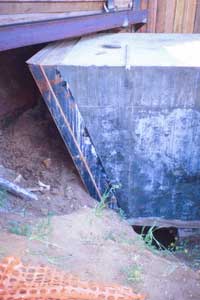Jacking
Jacking is a general term used to described a class of tunneling where the tunnel lining is pushed
through the ground using hydraulic rams. This technique has many benefits when employed in the proper conditions,
allowing tunneling to be performed safely, with very little ground settlement, and in conditions with limited ground
cover. The technique began to be used in the United States in the 1970's begining with operations where small diameter
pipes were jacked through the ground. The size of the structures that are jacked have changed over the years and it is
no longer limited to relatively small diameter pipe but now is used with large diameter pipes and box culverts.
Berkeley Engineering has jacked pipes and boxes up and down the state of California. We recently completed jacking a 14'
wide x 11' high reinforced concrete box culvert beneath an active expressway in Northern California.
|
 |
Box Jacking
Box Jacking is an innovative approach to provide for large conduits where trenchless technologies are desired. They can be of any size
but are most often found when the sizes exceed pipe sizes that can be easily handled, approximately 10 foot diameter pipe. The process typically
consists of first constructing a backstop that can be pushed against be the jacks. Next a launch slab is constructed which will form a guideway
for the box. The box is then cast onsite using similar techniques as is typical for reinforced concrete box culverts. Once the box is cured,
Jacking begins. This is a sequential process that includes pushing the box, excavating the face and hauling spoils, and extending the thrust members.
This process is repeated until the box reaches its final position. The loads that are required to jack the box are dependent on the ground type,
the size of the box, the overburdern, and the amound of build up allowed to accumulate in the face of the box. Boxes can be jacked through embankments that
have any range of ground types and the amount of overburden can range from inches to any number of feet. The most cost effective set up would have the top of box
being at least several feet from the road surface, however, it is possible to be only a few inches as was the case in a project we completed for CalTrans
in 1998 under an active state highway. See the following photographs for a depection of a project we recently completed.
|
| |
 |
Pipe Jacking
Pipe Jacking is a very similar process to box jacking only precast concrete or steel pipe is used in lieu of the reinforced concrete box. This technique
is widely used for short crossings for pipelines when interruption to highways or railroads is not allowed. A jacking pit is built and a jacking frame is
lowered into the pit. A digging shield is put into pit mounted on the first section of pipe and jacking is begun. This process uses multiple pipe sections
which are connected together during the operation. As the size of the pipe increases, the joints can serve as stress concentration points and care must be
taken to maintian strict line and grade so that the joints do not get overstressed. This technique can be done under many diffent conditions and through many
types of ground. Lengths can range up to 300' to 400' from a single jacking pit if conditions are favorable.
|
|

